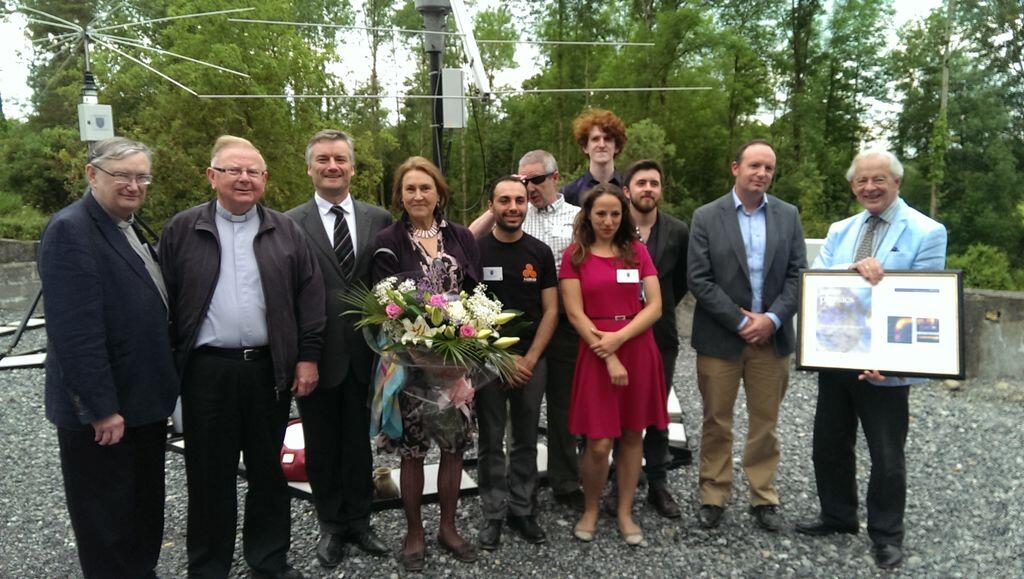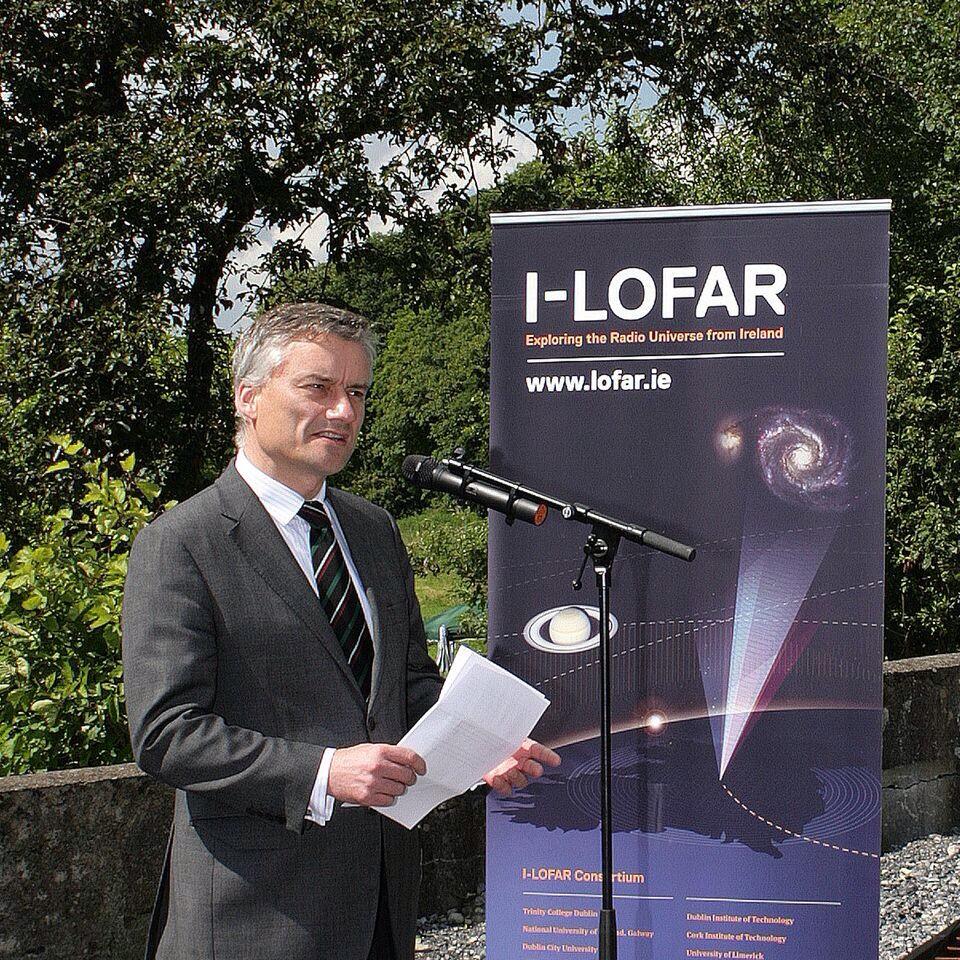AN IMPORTANT day in the history of Birr Castle took place on
Saturday afternoon when a new space observatory was officially
launched. This new
observatory could be part of something very exciting indeed because it
is possible that one day it could detect the existence of
extra-terrestrial life. If the project comes to fruition it will also be
part of a system which will expand our knowledge of the early evolution
of the universe.
The
new Observatory is called the Rosse Solar-Terrestrial Observatory and
it is located in former farmsheds and fields in the Mount Palmer section
of the Demesne. A
number of antennae are already in place in the Mount Palmer area, the
farm sheds have been considerably renovated, and €300,000 has been
raised for the project. Fundraising
efforts are currently underway to raise another €1.2 million for the
scheme, and the Castle and Trinity College Dublin are appealing to the
business people of Birr and Offaly to financially support this exciting
project.
Businessmen
Dermot Desmond and Denis O'Brien have both contributed €50,000 each to
I-LOFAR. Birr businessman Stevie Grant has also contributed a
significant amount. The Department of Jobs, Enterprise and Innovation is
currently considering whether it will give funding to I-LOFAR and is
due to make an announcement on the matter during July.
Speaking
during Saturday's launch Brendan Parsons Lord Rosse said his ancestors,
the 3rd and 4th Earls, would have been very excited and proud to see
this new development. He said that in terms of ambition and breaking new
ground, this project was on a parallel with the giant telescope
constructed in the demesne in the 1840s. He pointed out that the Third
Earl studied in Trinity College Dublin. He said the renovated farmsheds
were built during the 5th Earl's time, who brought over an agricultural
adviser from Denmark. 'He was more interested in agriculture than in
science.' He said the I-LOFAR project is a dynamic and exciting scheme.
Professor
Peter Gallagher, School of Physics, Trinity College, recalled that he
first visited the farmsheds four years ago and they were full of sheep.
Now the sheep have been moved elsewhere and have been replaced by a
building devoted to Astrophysics. He commented that the Rosse
Solar-Terrestrial Observatory is already a working observatory. He said
the antennae which are already in situ and working are able to pick up
radio waves being emitted by the sun. Clouds are not a barrier to their
ability to function.
Professor Gallagher added
that the antennae are also able to monitor the Earth's ionosphere which
can be helpful in forecasting disruptions in communication systems. He
pointed out that one of the Birr antennae detected a major solar burst
and this fact was reported in 'Nature Physics', a leading Science
magazine.
'The
ambition is to convert the farmsheds into a lecture area suitable for
visiting students.' The Professor added that while raising €1.2 million
may seem like a large sum of money, in the context of science projects
it is not a large sum. He praised Deputy Marcella Corcoran Kennedy who,
he said, has been very supportive of I-LOFAR, including travelling with
an I-LOFAR, fund-seeking delegation to the EU Parliament earlier on in
the year.
I-LOFAR is the name for the Irish
version of this international project with the 'I' standing for 'Irish'
and 'LOFAR' standing for 'Low Frequency Array.'
'Birr's
tradition and radio-quiet environment make it an ideal location for
being part of what is, when all the radio telescopes throughout Europe
are combined as one, the largest low frequency radio telescope in the
world,' said the Professor. 'I-LOFAR will not only attract additional
visitors to Birr, but will contribute to Ireland emerging as a key
player in international research and development.'
I-LOFAR
will be part of an international network of radio telescopes which are
referred to as LOFAR. LOFAR is currently up and running on a Europe-wide
basis with about 60 radio telescopes throughout the continent including
Sweden, France, Britain, Germany and Holland (there are 42 radio
telescopes in Holland). €150 million in funding has been invested in the
project and this funding has come from National Science Agencies and
the European Regional Development Fund. The aim of LOFAR's work includes
providing new views of exploding stars, and detecting previously
unknown planets. Each radio telescope consists of multiple antennae.
LOFAR will enable the study of Black Holes (which were predicted by
Einstein's General Theory of Relativity).
'Lord
and Lady Rosse have been nothing short of magnificent since we first
came to Birr,' remarked Professor Gallagher. 'On every visit they have
been very hospitable to us.' He complimented George Vaugh for helping
renovate the farmsheds. 'George did a great deal of work including
bringing gravel to the area, as well as electricity.
Our name for the sheds now is the control room. This is a good start and I think we have a bright future.'
Dr
Patrick Prendergast, the Provost of Trinity College, said he was
delighted to be present. He said the connection between Trinity College
and the Parsons family goes back hundreds of years. It was a connection
which was devoted to the love and pursuit of knowledge. It was a
connection which was dedicated to science and which also possessed a
strong sense of public service.
He commented
that as a student in Trinity in the 1770s Sir Lawrence Parsons, the
second Earl, was an auditor in the university. He represented Dublin
University in the Irish House of Commons. 'We are very proud of him in
Trinity College. As an MP he spoke strongly for independence and
integrity. He was praised by Wolfe Tone who said he was one of the few
honest men in the Irish House of Commons.
'The
Third Earl was a truly remarkable man who in 1845 constructed the Hubble
telescope of its time, which is an extraordinary piece of scientific
heritage for Ireland. Using his telescope the Third Earl drew the very
first images of the Milky Way. He possessed the same qualities of
integrity and decency as his father. He was a vocal critic of the
government in London during the famine and he told them the situation
was desperate. He was an important voice of compassion and economic
sense. In 1862 he was made a chancellor of Trinity.'
The
Provost said the Third Earl handed on his passions and enthusiasms to
his children, and the Fourth Earl's brother, Algernon, invented the
steam turbine.
He said the current Earl, the
7th Earl, has continued the great family tradition of a love and pursuit
of knowledge. He said the 7th Earl was recently elected an honorary
member of Trinity College.
'Today is another
milestone in the Parsons family's long commitment to science. I want to
thank them for their marvellous generosity. To engage in astrophysics in
a place which is crucial in the history of astrophysics is something
special.'
Lord Rosse said that when the giant
telescope was officially opened in 1845 a local clergyman walked up and
down the inside of the barrel of the telescope blessing it as he went.
He asked two local clergymen, Archdeacon Wayne Carney and Fr Tony Cahir,
to bless I-LOFAR in Birr using water taken from St Brendan's Well in
the demesne.
Fr Cahir quoted Pope Francis who
recently, during an astronomers' convention, pointed out that, 'It is
only right that men and women everywhere should have access to research
and scientific training. The hope that one day all people will be able
to enjoy the benefits of science is one which spurs all of us on,
scientists in particular. Only a fraction of the global population has
access to such knowledge, which opens the heart and the mind to the
great questions which human beings have always asked: Where do we come
from? Where are we going? The search for an answer to these questions
can lead us to an encounter with the Creator, the loving Father, for in
him we live and move and have our being.'
Archdeacon
Carney quoted from the Book of Sirach: 'All creation obeys His will. He
declares what is past and what will be. Not a thought escapes Him.
Nothing can be added to him, nothing taken away. Who could ever grow
tired of gazing at His glory?'
If you would like to make a donation to the I-LOFAR project please contact Professor Gallagher at (087) 6568975.























